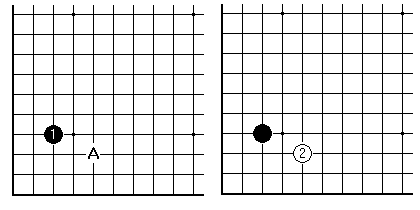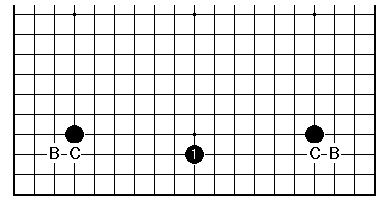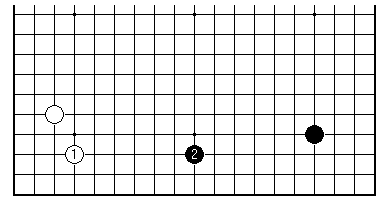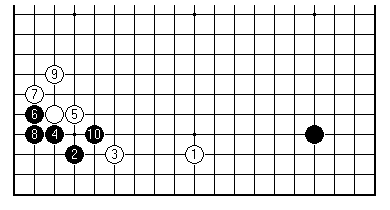

It's a sparse evening at Dan's. Some frivolity in competition no doubt - world-class football on TV, possibly. When a few of those present drift away games become desultory, and finally a small group are sat round for a chat.
Talk turns to what people think about the opening in Go. Is there any theory? Why certainly, and most elaborate too. Is it useful to study, and if so, at what point? This raises a crop of well-defended opinions. Resources? There seems to be plenty to say.
After a while we gravitate to the well-worn question - is there really a theory you can point to? What if Black starts in the centre of the board? This isn't unknown, though it goes against the conventional wisdom that the corners are the best places to start. With four empty corners left Black can still expect to occupy two. How can one assess the value of a single stone in the centre? Its impact on any fight breaking out on the sides will be positive for Black. But on the other hand its territorial effect might be minimal.
This topic leads us onto one of the best-loved tales. A few years in the 1930s saw the shinfuseki or "modern opening" style blossom in Japan. This period certainly saw a massive volume of innovation in openings from the younger players in the Nihon Ki-in (which had at that point been set up for less than a decade), led by two outstandingly strong young men, Kitani Minoru and Go Seigen. The classical opening theory in which the 3-4 point was the default in a corner, leavened by use of the 3-5 and 4-5 points, was swept away by 4-4 points, unheard-of 3-3 points, 5-5 and 6-4 points, in a promiscuous rush towards experimental formations of all kinds.
Naturally enough this tide of change has been represented as a return to a golden age of free-thinking after a claustrophobic orthodoxy, a Kuhnian paradigm-shift based on a re-evaluation of the respective worth of territory and outside influence, a belated equivalent of the chess hypermodern movement, a clean epistomological break. None of this is entirely misplaced, though the underlying model of an avant garde movement is a clear European imposition. When komi was introduced half a century ago in the top tournaments, players very much reverted to a tight, territorial style. It was only around 1970 when a further shift and fresh generation started the current trend to start routinely on the 4-4 point.
At this point in the conversation some inward squirming from the novices becomes verbally manifest. Would someone please give half-a-dozen pointers to the basics of opening play? Talk about pro-level openings assumes deep background. How about a short checklist?
Here goes, then, assuming not very much:
Now some pros will castigate this sort of talk - much too mechanistic. However it gets one started. Here are a few examples.

This is the classical sequence of corner occupation. If Black plays at 1, it is with the intention of playing next at A for an enclosure, one of the ideal formations. White can challenge that plan with an approach shown as play 2; according to the principles just given this has a high priority after all corners have been occupied.

The value of plays on the sides isn't absolute, but affected by the adjacent corners. Here Black 1 is towards the top end of the scale. It helps both black corners - with it in place Black can confidently answer the 3-3 invasions at the points B by blocking at C to make a wall in good relation to Black 1. (NB professionals would normally play this one line higher; but that's a nuance.)

In this position White should enclose the corner as shown. Then Black 2 is a major big point. A white play at this point would combine very well with the enclosure.

This is what might happen if White placed a higher value on the extension on the side than on the enclosure. When Black comes in with 2, White plays an aggressive pincer. However Black's choice of 4, rather than a standard corner opening from the book, is most sensible. Black lives in the corner - the book variations don't take into account the position of White 1 on the fringes of the possible fight. (So much the worse for them - this is one of the key limitations of "the book".) The end result can be evaluated as adequate for Black, since White hasn't made much territory.
As might have been anticipated, as soon as we get down to concrete examples there is an orgy of toss-arguing and a welter of hypothetical questions posed. Conventionally Go opening theory is divided into joseki, concerned with the book corner openings, and the deeper fuseki, about whole-board openings. Then fuseki is supposed to deal with general principles, as well as concrete variations, for the very good reason that the range of possibilities is so immense. Initiates gradually come to see that these are three legs of one stool: you get nowhere with fuseki analysis without a background in standard local sequences, and so on. Go in the West has always attracted those of a strong maths, computing or science background, mystifying orientals who don't see the connection beyond a certain point. The fact that the opening foundations seem not to be axiomatic, but a bootstrap construction with several dense centres, illustrates the Eastern point of view quite well.
First published 20 April 2000 as On Your Side on MindZine,
Go Learning
© Charles Matthews 2000.